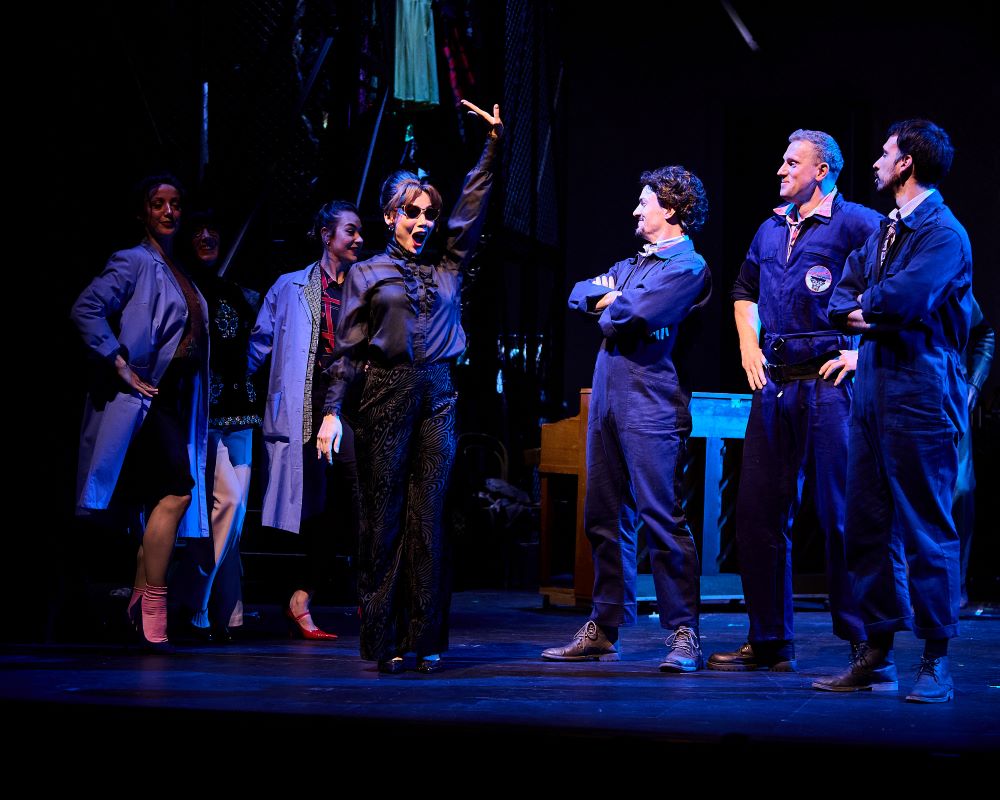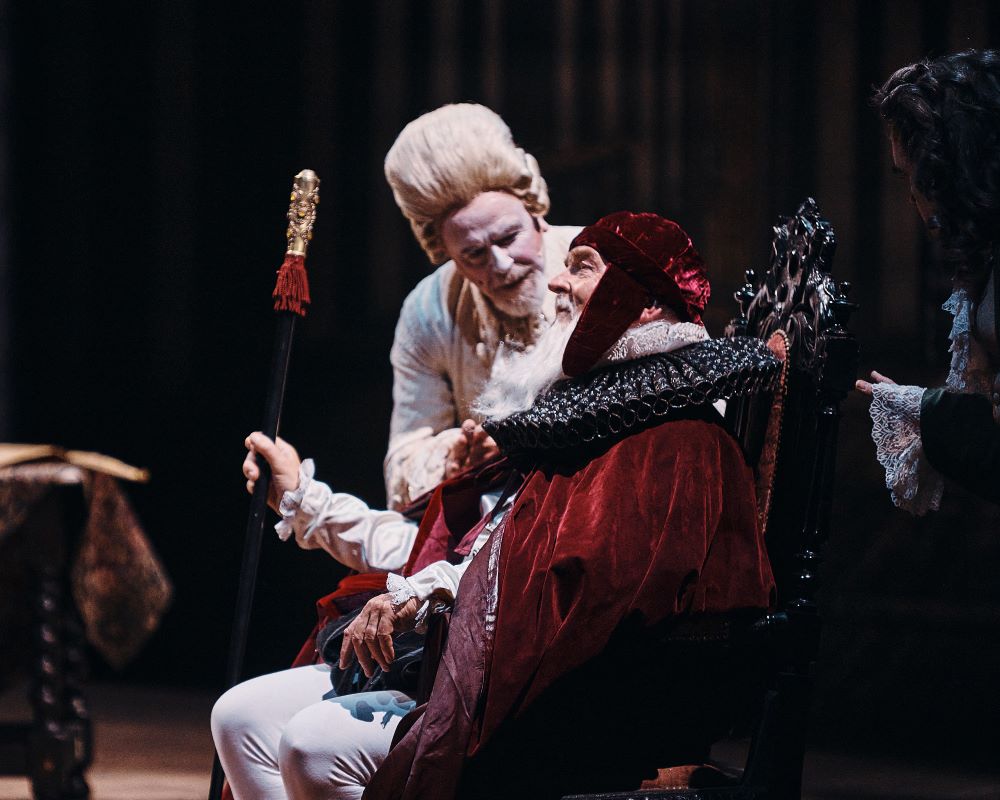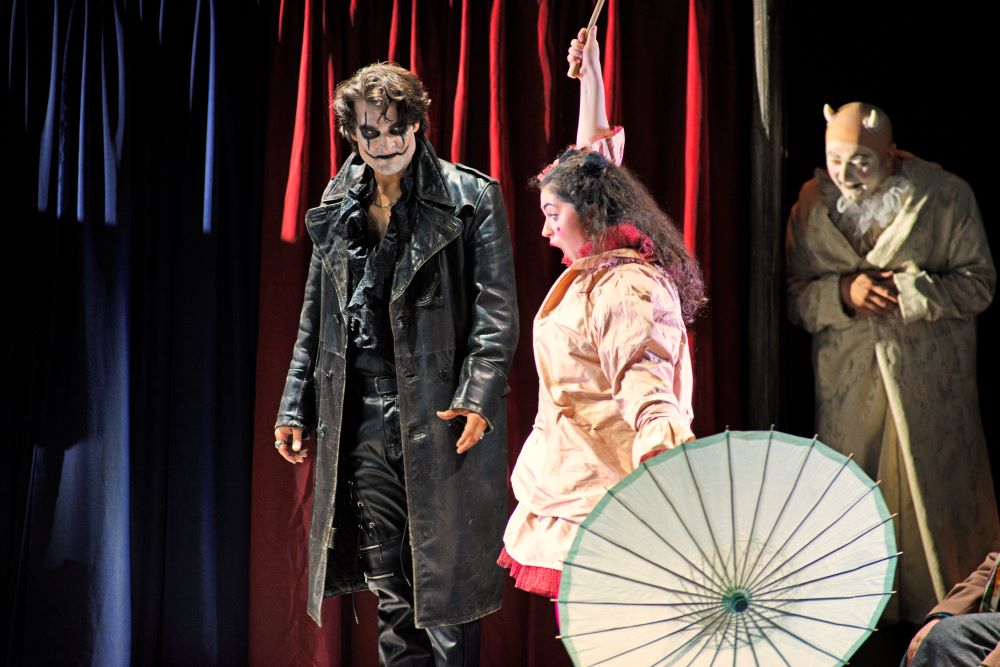Name three operas framing dramas within, and you’d probably come up with Leoncavallo’s Pagliacci, Strauss’s Ariadne auf Naxos and Prokofiev’s The Love for Three Oranges. You might be harder pressed to come up with three more, but Wexford Festival Opera has done just that, theming this year’s triptych of rarities in the shape of never less than interesting, if often dramatically flawed, comedies by Donizetti, Mascagni and Stanford as “Theatre Within Theatre”.
Nothing sinks to the dud level of Halévy’s La tempesta in 2022 or Erlanger's L’aube rouge last year. And nothing in the state-of-the-art opera house above the Slaney, in my brief Wexford experience, has soared as high in every department as a very special “performing version” of Donizetti’s Le convenienze ed Inconvenienze teatrali (“Conventions and Inconveniences of the Stage”,★★★★★). This could run and run with the more wieldy title of Viva la Mamma, after the drag baritone role of the stage mother from hell/comic heaven, or Viva le Dive, since the Prima Donna, an ideal coloratura soprano, is also a total star here.
Director Orpha Phelan also offered up the most imaginative show of 2022, a production which lifted the modest charms of David’s Lalla-Roukh. To gild Donizetti and Gilardoni’s rather repetitive and illogical business around a mediocre regional Italian company’s attempt to stage a new opera, Romolo ed Ersilia, Phelan has not only taken the justifiable liberty of making Act Two, about which the Donizetti Critical Edition is far from clear, a semi-contemporary pasticcio of numbers by other composers, but avoids the pitfalls of repeating gags with constant ingenuity.  In this she is abetted by the brilliant choreography of Amy Share-Kissiov, gamely and expertly executed by six dancers. It’s apparent from an early sequence involving somehow hilarious pelvic thrusting that this will be “Donny Zitti – the RuSical”, and candidate for an easy winner of RuPaul’s Drag Race soon appears in the shape of Italian buffo baritone Paolo Bordogna as Agata Scannagalli, interfering mamma of seconda donna Luigia Castragatti (Paola Leoci, who finally gets to shine when she’s allowed to sing properly).
In this she is abetted by the brilliant choreography of Amy Share-Kissiov, gamely and expertly executed by six dancers. It’s apparent from an early sequence involving somehow hilarious pelvic thrusting that this will be “Donny Zitti – the RuSical”, and candidate for an easy winner of RuPaul’s Drag Race soon appears in the shape of Italian buffo baritone Paolo Bordogna as Agata Scannagalli, interfering mamma of seconda donna Luigia Castragatti (Paola Leoci, who finally gets to shine when she’s allowed to sing properly).
Bordogna leaves no nuance unturned as he veers between pantomime dame and convincing impersonation of an Italian lady of a certain age. In Act Two he gets to word-mangle the Willow Song from Rossini’s Otello (yes, the other one) with a vegetable language, part of the original, and sings in his baritone voice “Per lui che adoro” from L’Italiana in Algeri while Luigia mimes to try and seduce in no subtle terms the beleaguered impresario (Philip Kalmanovitch; the three pictured above by Patricio Cassinoni). Not only that, but Bordogna’s fine legs are put to good use en pointe in a genuinely hilarious (and clever) ballet to the pretty music of Mysliveček (who composed a genuine Romolo ed Ersilio).  Mamma Agata’s thunder also gets stolen, whenever the Prima Donna gets to sing a number, by Daria Garbinati. Sharleen Joynt has everything it takes – charisma, energy and a perfect coloratura which succeeds, despite the first notes, in her “serious” first aria (pictured above by Patricio Cassinoni) and in... now what’s that cor anglais starting up in Act Two? It’s “Glitter and Be Gay” from Bernstein’s Candide – Joynt has sung Cunegonde in Lyon – and every note of it, plus a few more over the top, plus a concluding dance sequence.
Mamma Agata’s thunder also gets stolen, whenever the Prima Donna gets to sing a number, by Daria Garbinati. Sharleen Joynt has everything it takes – charisma, energy and a perfect coloratura which succeeds, despite the first notes, in her “serious” first aria (pictured above by Patricio Cassinoni) and in... now what’s that cor anglais starting up in Act Two? It’s “Glitter and Be Gay” from Bernstein’s Candide – Joynt has sung Cunegonde in Lyon – and every note of it, plus a few more over the top, plus a concluding dance sequence.
Also allowed to shine is Mexican tenor Alberto Robert as a character who was originally "the German tenor" and here imagines he's been engaged to sing Captain von Trapp in The Sound of Music; despite trying to fit "Edelweiss" to Donizetti, he gets a lovely aria (from Don Pasquale, no less) to sing at the beginning of Act Two, as a kind of intermezzo. The connection, however loose, is that he will go away to a place where his beloved Rodgers and Hammerstein might bloom and grow. There’s everything else you could wish for – pattery ensembles and Act 1 finale a la Rossini which make Donizetti comedies so much more entertaining than his queenly tragedies, all perfectly paced by conductor Danila Grassi, old-fashioned prettiness with mobile temples as the “opera” gets underway as designed by Madeleine Boyd, and so much hard work from the young and excellent chorus, who also feature as soloists in other offerings throughout the festival (more anon). But it’s Bordogna and Joynt who give the outstanding performances of the three operas.

The other lunchtime recital I heard, from Irish mezzo Carolyn Holt and humorous pianist Nate Ben-Horin (★★★★), reinforced how fine this singer is in baroque repertoire. She had been a handsome Cornelia in Blackwater Valley Opera Festival’s Handel Giulio Cesare, and the highlight of this hour was “Sposa son disprezzata” from Vivaldi’s Bajazet. Holt’s role(s) in Stanford’s The Critic, (★★★★), another of the main festival offerings, were brief, but her impact as Justice’s Lady in a brief but genuinely funny scene of long-lost son’s reunion with mother and father showed star presence.
This came at the beginning of a second act which was lighter of touch, and richer in laughs, than the first. Stanford had the tricky idea, as late as 1915 (after the original version of Ariadne auf Naxos, by the composer he detested, Richard Strauss, not least for praising the far greater Elgar as “first English progressivist”) of turning Sheridan’s 1779 satire on bad plays into a more laboured one on bad operas.  The problem here, as any composer who’s tried to set a straight play will tell you, is that music takes far longer to tell the story than words alone. Filleted Sheridan excising much of the original first act left us with three main spoken roles; Arthur Riordan’s Sneer and Jonathan White’s Dangle, now a composer, came across more clearly than Mark Lambert’s Puff (the three pictured above by Patricio Cassinoni with orchestra and conductor Ciarán McAuley) . More text was lost when the three sat in a box at the back of the stage while the singers performed with their backs to them and out to us, the audience. The situation improved in the second act, with seats downstage left and right and John Comiskey’s illusionist sets coming into their own. The staging, by Conor Hanratty, was never less than honourable.
The problem here, as any composer who’s tried to set a straight play will tell you, is that music takes far longer to tell the story than words alone. Filleted Sheridan excising much of the original first act left us with three main spoken roles; Arthur Riordan’s Sneer and Jonathan White’s Dangle, now a composer, came across more clearly than Mark Lambert’s Puff (the three pictured above by Patricio Cassinoni with orchestra and conductor Ciarán McAuley) . More text was lost when the three sat in a box at the back of the stage while the singers performed with their backs to them and out to us, the audience. The situation improved in the second act, with seats downstage left and right and John Comiskey’s illusionist sets coming into their own. The staging, by Conor Hanratty, was never less than honourable.
Stanford’s ideas and orchestration are honourable, too, but setting up Puff/Dangle’s The Spanish Armada smacked too much of a duller equivalent to Gilbert and Sullivan’s The Yeomen of the Guard, despite fine singing actors Ben McAteer as Raleigh and Oliver Johnston as Sir Christopher Hatton. The set-up of a pointedly implausible love between fort governor’s daughter Tilburina and imprisoned Spaniard Don Ferolo Whiskerandos involves a fairly straight love duet, weighed down by repetitions urged by Puff; Ava Dodd (pictured below by Patricio Cassinoni with Hannah O'Brien as her confidante) can only come into her own in a curious little Mad Scene in Act Two, preceded by a witty death for Dane Suarez’s ill-fated lover.  The biggest laughs, from me at any rate, came with the stately-ludicrous appearance of Lord Burleigh, to a melancholy cello solo promising something along the lines of Philip’s “Ella giammai m’amo” in Verdi’s Don Carlos. But he sings not a note – visible rumination is enough in the stage debut of Wexford Light Opera Society and Drama Group doyen Tony Brennan (bravissimo, pictured below by Patricio Cassinoni with Mark Lambert).
The biggest laughs, from me at any rate, came with the stately-ludicrous appearance of Lord Burleigh, to a melancholy cello solo promising something along the lines of Philip’s “Ella giammai m’amo” in Verdi’s Don Carlos. But he sings not a note – visible rumination is enough in the stage debut of Wexford Light Opera Society and Drama Group doyen Tony Brennan (bravissimo, pictured below by Patricio Cassinoni with Mark Lambert).
An aria isn’t exactly forthcoming for Gyula Nagy as vengeance-seeking sea captain in Beefeater disguise; instead Puff pinches a line from Othello for him, and Dangle decides to match it with the second Beethoven Nine quotation of the evening. I now forget if it’s here that we get a hint of Hans Sachs’s Wahnmonolog, but there are plenty of witty references, and pastiche of Wagnerian elemental music, including nice wave-motions for a masque of Elizabeth’s victory over the Armada, where the music is better than the staging. Ciarán McAuley’s conducting has tremendous sheen and energy. It’s a not entirely successful evening, but shows admirable support for a freedom-fighting Irishman (what an extraordinary life Sheridan led) and a Protestant Dubliner who might in many respects be seen as his opposite.
I now forget if it’s here that we get a hint of Hans Sachs’s Wahnmonolog, but there are plenty of witty references, and pastiche of Wagnerian elemental music, including nice wave-motions for a masque of Elizabeth’s victory over the Armada, where the music is better than the staging. Ciarán McAuley’s conducting has tremendous sheen and energy. It’s a not entirely successful evening, but shows admirable support for a freedom-fighting Irishman (what an extraordinary life Sheridan led) and a Protestant Dubliner who might in many respects be seen as his opposite.
Hanratty drew the right laughs in last year’s main show from the young artists of the Wexford Factory, L'Italiana in Algeri, with singers to match. This year’s offering, Leoncavallo’s Pagliacci (★★), so failed the stagecraft of a brilliant melodrama that I pass over the director and some serious miscasting (to be fair, Nedda was triple-cast, so I may have drawn the short straw). It's enough to say that the Canio seemed to have fallen from heaven to infertile earth in the shape of American Samuel White (pictured above by Pádraig Grant with a different Nedda from the one I saw, and Giorgio Lomiseli as a fine Tonio). White could sing this semi-helden role anywhere in the world now. Good-looking young tenors up to the heroic mark aren’t ten a penny, either, and on the evidence of a Facebook and a YouTube clip, he may be the Siegmund and Parsifal opera houses are looking for.
It's enough to say that the Canio seemed to have fallen from heaven to infertile earth in the shape of American Samuel White (pictured above by Pádraig Grant with a different Nedda from the one I saw, and Giorgio Lomiseli as a fine Tonio). White could sing this semi-helden role anywhere in the world now. Good-looking young tenors up to the heroic mark aren’t ten a penny, either, and on the evidence of a Facebook and a YouTube clip, he may be the Siegmund and Parsifal opera houses are looking for.
Had the production been more compelling, Pagliacci might have stolen all the thunder from the weirder attempt at a commedia dell’arte theatre-within-theatre we got in the evening, Mascagni’s Le maschere (★★★). As drama, it’s hopeless: we’re promised (in a very well-spoken prologue from Peter McCamley) the real faces behind the masks. Instead Mascagni’s librettist, the experienced Luigi Illica, gives us a shallow farce devoid of wit in which the main device is a non-starter: a powder rendering the victim a spouter of nonsense to be fed to Captain Spavento, the unwanted suitor of young Rosaura, who loves Florindo. Mascagni had his doubts, and should have been more insistent that Illica come up with something better.  The music, however, has some first-rate sequences which should have been served up in a worthier context: an ensemble too big and emotional for the circumstances and dominated by the lovers, whose duet extends it, a quirky serenade and two good dance numbers. There are no laughs extracted in Stefano Ricci’s production: his decision to set it all in a wellness spa adds nothing except a visual handsomeness from time to time (Ricci is also the designer). The changes out of 18th century costume and into contemporary roles promise much, but deliver little.
The music, however, has some first-rate sequences which should have been served up in a worthier context: an ensemble too big and emotional for the circumstances and dominated by the lovers, whose duet extends it, a quirky serenade and two good dance numbers. There are no laughs extracted in Stefano Ricci’s production: his decision to set it all in a wellness spa adds nothing except a visual handsomeness from time to time (Ricci is also the designer). The changes out of 18th century costume and into contemporary roles promise much, but deliver little.
All the pleasures come from the orchestra, under the experienced baton of Wexford regular Francesco Cilluffo, and from some of the singers, chiefly Lavinia Bini as Rosaura (pictured above by Patricio Cassinoni with Andrew Morstein's Florindo) and Gillen Munguia’s Brighella. The rest are never less than good, if called upon to do some ungainly dramatic things. Le maschere could be heard again in concert, but certainly isn’t worth the staging. But it still made for fascinating comparison in the context of the Theatre Within Theatre theme; the mind was made flexible with constant comparison.















Add comment